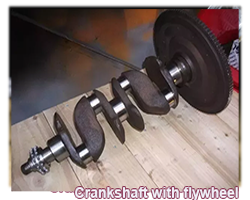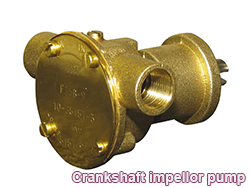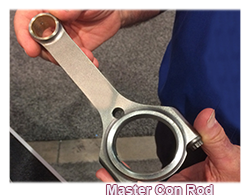
DEGREE WHEEL:  Describes wheel-like disc divided into 360 equal parts attached to the engine crankshaft to set the valves' timing to a higher degree of accuracy.
Describes wheel-like disc divided into 360 equal parts attached to the engine crankshaft to set the valves' timing to a higher degree of accuracy.
FLYWHEEL: Describes a relatively large and heavy metal wheel attached to the crankshaft's back to smooth out the firing impulses. The flywheel also forms a base for the starter ring gear and the clutch assembly in manual transmission.
FLYWHEEL MAGNETO: Describes a magneto mounted in the flywheel of a two-stroke engine.
FLYWHEEL PULLER: Describes a specially designed tool with three arms and a centre stud used to remove the flywheel.
FLYWHEEL RING GEAR: Describes a gear on the flywheel's outer circumference in which the starter drive gear engages the ring gear to crank the engine.
HARMONIC BALANCER. Describes a fitting situated at the pulley end of the crankshaft designed to absorb excess engine vibrations.
GROUND AND POLISH: Describes the procedure of cutting and polishing a crankshaft bearing surface according to precision specifications.
IMPELLER: Describes a torque converter, the driving member connected to the crankshaft via drive plate and converter cover that generates the converter's fluid flow.
MASTER CON ROD: Describes the connecting rod articulated directly on the crankshaft, found in two-stroke dual-piston engines.
MAIN BEARINGS: Describes the bearings in the engine block that support the crankshaft.
OFFSET CRANKSHAFT: Describes a type of crankshaft layout where the crankshaft axis and the piston pin do not intersect because the piston forces do not work uniformly on the walls of the cylinder through the skirt of the piston.
PILOT BEARING: Describes the small bearing set in the centre of the flywheel end of the crankshaft, supporting the forward end of the clutch shaft.
POSITIVE CRANKCASE VENTILATION (PCV): Describes a process developed in the early Sixties designed to harness the build-up of harmful acid-producing combustion gases within the crankcase.
POSITIVE CRANKCASE VENTILATION VALVE(PCVV): Describes a one-way valve that controls vapours' flow from the crankcase into the engine.
TRANSAXLE: Describes a setup in rear-engine cars where the clutch, differential, gearbox and final drive are combined into a single unit connected directly to the driveshaft.
STROKED CRANKSHAFT: Describes a crankshaft with its connecting rod thrown off so that the length of the stroke increases.
 Describes a method used to increase the displacement of an engine through lengthening its crankshaft throws, causing the piston stroke to increase.
Describes a method used to increase the displacement of an engine through lengthening its crankshaft throws, causing the piston stroke to increase. 

